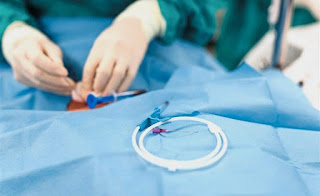Can We Reuse Medical Devices Meant To Be Used Only Once? - The knowledge and skills of doctors in the management of health conditions, have been complemented by medical devices.
The Medical Device Authority (MDA) defines medical devices as “any product used in healthcare for the diagnosis, prevention, monitoring or treatment of illness or handicap, but excludes drugs”.
Prior to the 1970s, most medical devices, which were made of rubber, glass or metal, were reused after cleaning and drying, with some sterilised by steam.
Since then, there has been an increasing number of single-use medical devices manufactured because of user demands, complexity of new devices and the introduction of sterilisation by ethylene oxide and radiation.
The design of the new devices are more complex and intricate.
The trend towards the usage of single-use medical devices have been matched by a counter trend towards the reuse of single-use devices.
The Health Ministry (MOH) disclosed recently that “The MDA has conducted a preliminary survey to look into this practice in the public and private hospitals.
“Interestingly, the finding revealed that 37% out of 40 private hospitals surveyed reuse and reprocesse the single-use devices, similar to the practice in MOH hospitals.”
Some patients have understandably raised concerns following the disclosure, which has also generated debate among doctors.
Case and concerns for reuse
The economic case for reuse of single-use medical devices is cost savings. With the reprocessing and reuse of devices, the cost of a procedure may be reduced, thereby making it available to a larger segment of the population who may otherwise not be able to afford it.
This argument is often stated when there are resource limitations.
The environmental case is that reuse leads to less medical waste, which contributes to costs associated with proper disposal and environmental contamination.
When a manufacturer states that a medical device is for single-use, it means that it is safe for one use only.
Any reprocessing for reuse has to ensure that the device is sufficiently clean or sterile, and functions properly, so that the reused device does not pose a risk to the patient for whom it is used.
The question is whether the reprocessor, whether a third party or in the hospital, has the same technical expertise as the manufacturer, and in the case of a hospital, whether it has sufficient facilities for reprocessing.
If not, the device will be reused without adequate evaluation, which may then lead to increased risk to patients.
The concerns of the World Health Organization (WHO) about the reprocessing of single-use devices include that:
• Single-use devices may not be designed to allow thorough decontamination.
• Reprocessing may alter device characteristics, and may compromise its performance as a result.
• Single-use devices do not undergo extensive testing and validation for reuse.
• Single-use devices may cause cross-infection due to design, e.g. fine bores of tubes.
• Some materials can absorb certain chemicals, which can gradually leach from the material over time.
• Chemicals may corrode or change device materials.
• Device material may experience stress during reuse and may fail, stretch or break.
• Inadequately cleaned equipment can carry bacterial endotoxins, which remain after the bacteria are killed.
In addition, the abnormal proteins associated with prion diseases, e.g. bovine spongiform encephalopathy (BSE), commonly known as mad cow disease, are very resistant to all methods of decontamination.
When a single-use device is no longer safe or suitable for reuse is another pertinent question.
Variations in regulation
The reprocessed single-use devices in developing economies include urinary catheters, nasal masks, syringes and catheters.
In developed economies, the reprocessed devices are expensive, high technology devices like cardiac pacemakers – this is considered safe if regulated and conducted safely.
A reprocessor in the United States has to comply with the same requirements as the original manufacturer before a single-use device can be reprocessed and reused. The US Food and Drug Administration (FDA) has a list of about 70 single-use devices that can be reprocessed.
A reprocessor of a single-use device in Australia becomes the manufacturer of the reprocessed device and is subject to the same regulatory standards. Canada has a similar requirement.
The Medicines and Healthcare Products Regulatory Agency of the United Kingdom advises against the reuse of single-use devices and of the legal implications of such practice.
Reuse of single-use devices is illegal in France.
The MDA’s position has not been publicised. Whether it has a list of single-use medical devices that can be reprocessed and the conditions for reprocessing, or whether it endorses the FDA list is unknown to doctors who perform various procedures.
Advice for patients and families
It is important to remember that medical devices are assigned risk classifications based on the risk of infection involved with its use:
• Critical – devices that come into contact with blood or normally sterile tissue, e.g. surgical forceps, implanted infusion pumps.
• Semi-critical – devices that come into contact with mucous membranes, e.g. endoscopes, ultrasound catheters.
• Non-critical – devices that come into contact with unbroken skin, e.g. stethoscopes, tourniquet cuffs.
The risk of infection is higher with devices classified as critical and semi-critical.
Prior to any procedure, it is advisable to ask the doctor what medical devices will be used and whether they are single or multiple use ones.
If single-use devices are to be used, information about its risk classification and whether it is a reused device has to be provided.
In the case of the latter, it would be prudent to ask about its safety from the infection and functionality perspectives.
Although there is no local data, there are reports from developed economies that it is not uncommon for doctors not to know whether single-used medical devices are original or reprocessed.
In the private sector, the question of the difference in the charges for a single-use and reused device has to be made known for consideration.
The reuse of single-use medical devices is a complex issue with public health, ethical and legal liability considerations.
However, patient safety and involvement have to be the paramount considerations in decision making.
Dr Milton Lum was a past president of the Federation of Private Medical Practitioners Associations, Malaysia, and the Malaysian Medical Association. The views expressed do not represent that of any organisation the writer is associated with. The information provided is for educational and communication purposes only and it should not be construed as personal medical advice. Information published in this article is not intended to replace, supplant or augment a consultation with a health professional regarding the reader’s own medical care. The Star disclaims all responsibility for any losses, damage to property or personal injury suffered directly or indirectly from reliance on such information.














